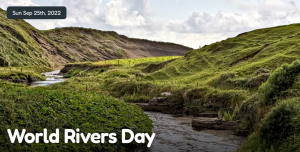BY DEBAJYOTI CHAKRABORTY
KOLKATA, 25 SEPTEMBER 2022
The findings of lack of adequate waste water treatment plants leading to the failure in stopping continuous discharge of toxic chemical industrial effluents in a recent study of a BRICS ( Brazil, Russia, India, China, South Africa) nations funded project has given alarming signals about the pollution level and contaminations of nine rivers in the country including the River Damodar and has also identified the likely future cancer hotspots of the state.

Today ( 25 September 2022) is World River Day and the theme this year is – ‘ the importance of Rivers to Biodiversity’.The World Water Week – 2022 has been observed from 23 August to 1 September in Stockholm of Sweden this year with the theme – “Seeing the Unseen : The value of water”.
The observations of the recent international study is very much significant.. Under the BRICS Multilateral Research Project, scientists of the countries will work together to study industrial discharge and identification of organic compounds in water.

Talking to The Travel and Tourism Times , Dr. Hirok Chaudhuri, associate professor of physics of National Institute of Technology (NIT) Durgapur and coordinator of BRICS Network University Programme has said that the main matter of concern is that the drinking water, bathing water, agricultural water and industrial water have highly toxic compositions which are much higher than the permissible limits set up by the World Health Organisation (WHO), United States Environmental Protection Agency and Bureau of Indian Standards (BIS).
“ For instance phenol , commonly known as carbolic, a by product of the steel plants located in the upper catchment area of River Damodar mixes as effluents and the permissible limit is .0001 mg whereas it has been found to be .1mg in Damodar water near Durgapur. It is even mixing with the groundwater. Damodar is the most polluted river in the country, even more polluted than Cauvery and Yamuna,”he added. The pH and the Total dissolved Solid percentage level is also very high.

Eastern India disposes of 18.32 percent of the country’s total wastewater generation. Presently, the wastewater treatment gap in the country in India is 74.95 percent of the country’s total waste water generation. It is a severe threat for the environment, ecology and human health.
Almost 11 rivers flow through different parts of the country and Damodar situated on the eastern part of the country is worst affected, the report says.
46 percent of the nation’s coal exploration takes place in the Damodar basin. Reserves of minerals like mica, quartz, fireclay, bauxite, limestone, hematite, , zircon, baryte, ironstone etc. Five integrated steel plants, eleven thermal power plants, ten cement plants, four hard coke plants, fourteen beehive coke oven plants, 64 refractories, 24 coal washeries etc are also operational in this basin.

There is carcinogenic health risk assessment. The chance of cancer is high in lifetime due to long exposure of the human body to carcinogenic heavy metals. The toxic heavy metals found are As,Cr,Ni,Cd etc.
The study recommends switching off the ground water withdrawn in some locations like in DPL colony, DSP industrial area in Durgapur and Bartaria village in Burnpur etc. The HMPI for the industrial area is six fold higher than the HMPI for the non industrial area. The water is unsuitable for oral intake and domestic usages.
As per the report, a carcinogenic risk assessment map has also been prepared with Durgapur, Burnpur and Asansol cities as more vulnerable areas in the entire basin due to carcinogenic health effects due to long term exposure. Cu,Fe,Mn, Ni, Hg are very high in groundwater.
It has recommended installing more wastewater plants in Bokaro, Dhanbad, Asansol, Durgapur and Burnpur. Particularly two cases of cancers are likely to be recorded in every 10 resident adults / children due to Ni via oral and dermal exposure pathways.
Imposing stringent pollution control measures, setting up scientific city and industrial sewage systems with treatment plants are recommended. A detailed medical survey for cancer and other serious health impacts are also recommended.
The study was based on physical, biological and chemical parameters. Samples were collected from 99 places of River Damodar. Impact on aquatic plants, fish growth and drinking and bathing of animals, cattles and birds were also studied.
The villagers living in the downstream areas and who have no facilities of getting municipal treated water and use Damodar water solely for daily agricultural and domestic purposes will be the worst victims, the report concludes.
Throughout the globe, World River day 2022 has been observed today with the need for the rivers to keep any civilisation going is the focus of this year’s theme. Not only humans, but the flora and the fauna which the rivers host inside also essential part of the world’s eco system . It should be noted that all the ancient civilisations had grown up besides the famous rivers throughout the world.

Advertisement:




























Add Comment